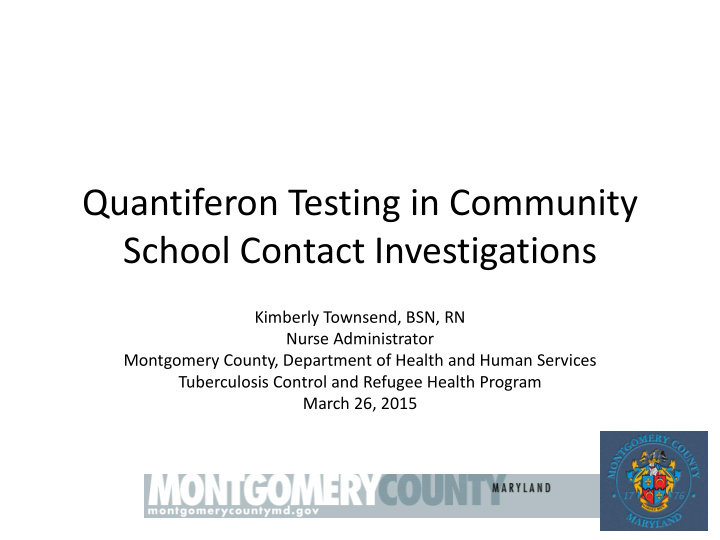



Quantiferon Testing in Community School Contact Investigations Kimberly Townsend, BSN, RN Nurse Administrator Montgomery County, Department of Health and Human Services Tuberculosis Control and Refugee Health Program March 26, 2015
Background Information SETTING PUBLIC MIDDLE SCHOOL PUBLIC HIGH SCHOOL Total # Students* `800 `1, 400 Demographics* 39% Hispanic, 14.5% ESOL 35% Hispanic, 7.7% ESOL Index Case 13 years of age; Peru; 17 years of age; Peru; infectiousness; smear status; infectiousness; smear status; positive PPD; entered U.S. positive QFT; entered U.S. 1/10/2014 2/18/2012 School Contacts Yes-students, teachers, bus Yes, -students, teachers Identified drivers Special School uses a 7-class period ESOL student; primarily shared Considerations schedule; primarily in class class time and activities with the with the same group of same group of students throughout students throughout the the school day; smaller that school day; average-sized average-sized classes; family drives classes; public school bus to school *http://www.montgomeryschoolsmd.org/departments/sharedaccountability/glance/
Contact Investigation: Screening Options • Tuberculin Skin Test (TST) • Quantiferon (QFT)
Screening Tool Selection • Population • Resources • Support – Department of Health and Human Services (DHS) – DHMH Public Health Laboratory (PHL) – Montgomery County Public Schools (MCPS) • Feasibility – Staff • Availability • Skills • Experience • New Approach
External Collaborative Partners • Maryland Center for Tuberculosis Control and Prevention Team (CTBCP) • Maryland DHMH Laboratory (PHL) • Montgomery County Public Schools (MCPS) • Local School Site Administration • Qiagen • Maryland Tuberculosis Control Program Jurisdictions
Internal Collaborative Partners • Montgomery County DHHS – Public Health Officer – Communicable Disease & Epidemiology Senior Administrator – Epidemiologist – Public Information Officer – Tuberculosis Control Program Team – Immunization Program Team – School Health Services Team – Emergency Preparedness Team
Communication with the School Community • School Administration and Staff – Initial meeting with leadership – Principal – Letters • Fact sheets • Options • Contact information – Phone – Face to face http://www.cdc.gov/tb/publications/factsh eets/testing/igra.pdf
Communication, cont’d • Parents and Students – Principal – Letters • Fact Sheets • Options • Contact Information – Face to face – Connect Ed
Logistics • Incident Command Services (ICS)- Like Model – Task specific staff assignment – Skills and ability – Structured work flow – Focus on efficiency (estimate length of time for each blood draw)
Logistics • Preparation • Initial meeting with site administration • Site visit by logistics team • Location at site • Set-up design • Supplies • Documentation
Logistics • Consent – Forms with signature – Phone • Communication of Results • Follow up with parents and students
Successes and Challenges What Worked Well What Were Some Challenges Collaboration Collaboration ICS Space/Lighting Coordination Resources Planning and training Consent Communication Follow up Logistics Supervision Specimen integrity and transport Emergency plan Understanding School policy and Snacks/water guidelines 92% tested at HS 76% tested at MS Evaluation Media coverage
Outcomes Outcome Public Middle School Public High School # Identified 196 149 # Screened (single-round) 156 143 # Positive 3 4 # Foreign-born Positive 3 4 # Completed TLTBI 2 2 # Declined TLTBI (total) 1 2
Outcomes SETTING PUBLIC MIDDLE SCHOOL PUBLIC HIGH SCHOOL Total # Students* `800 `1, 400 Total # Identified 196 149 Percent of Identified 76% Tested 92% Tested Tested/Evaluated Total # Tested Positive 3 4 Total # Completed TLTBI 2 2
Recommendations • Screening tool selection • ICS model • Resources and support • Communication • Collaboration • Preparation • Consent • Specimen transport • Biohazard waste disposal • Plan for the unexpected! • Flexibility • Consider population
Thank You! • Please use the microphone when asking questions
Recommend
More recommend